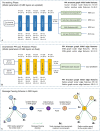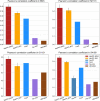MpbPPI: a multi-task pre-training-based equivariant approach for the prediction of the effect of amino acid mutations on protein-protein interactions
- PMID: 37651610
- PMCID: PMC10516393
- DOI: 10.1093/bib/bbad310
MpbPPI: a multi-task pre-training-based equivariant approach for the prediction of the effect of amino acid mutations on protein-protein interactions
Abstract
The accurate prediction of the effect of amino acid mutations for protein-protein interactions (PPI $\Delta \Delta G$) is a crucial task in protein engineering, as it provides insight into the relevant biological processes underpinning protein binding and provides a basis for further drug discovery. In this study, we propose MpbPPI, a novel multi-task pre-training-based geometric equivariance-preserving framework to predict PPI $\Delta \Delta G$. Pre-training on a strictly screened pre-training dataset is employed to address the scarcity of protein-protein complex structures annotated with PPI $\Delta \Delta G$ values. MpbPPI employs a multi-task pre-training technique, forcing the framework to learn comprehensive backbone and side chain geometric regulations of protein-protein complexes at different scales. After pre-training, MpbPPI can generate high-quality representations capturing the effective geometric characteristics of labeled protein-protein complexes for downstream $\Delta \Delta G$ predictions. MpbPPI serves as a scalable framework supporting different sources of mutant-type (MT) protein-protein complexes for flexible application. Experimental results on four benchmark datasets demonstrate that MpbPPI is a state-of-the-art framework for PPI $\Delta \Delta G$ predictions. The data and source code are available at https://github.com/arantir123/MpbPPI.
Keywords: equivariant neural network; multi-task pre-training; protein binding affinity change prediction; protein engineering.
© The Author(s) 2023. Published by Oxford University Press.
Figures




Similar articles
-
Graph masked self-distillation learning for prediction of mutation impact on protein-protein interactions.Commun Biol. 2024 Oct 26;7(1):1400. doi: 10.1038/s42003-024-07066-9. Commun Biol. 2024. PMID: 39462102 Free PMC article.
-
GeneralizedDTA: combining pre-training and multi-task learning to predict drug-target binding affinity for unknown drug discovery.BMC Bioinformatics. 2022 Sep 7;23(1):367. doi: 10.1186/s12859-022-04905-6. BMC Bioinformatics. 2022. PMID: 36071406 Free PMC article.
-
Multi-task bioassay pre-training for protein-ligand binding affinity prediction.Brief Bioinform. 2023 Nov 22;25(1):bbad451. doi: 10.1093/bib/bbad451. Brief Bioinform. 2023. PMID: 38084920 Free PMC article.
-
Deep geometric representations for modeling effects of mutations on protein-protein binding affinity.PLoS Comput Biol. 2021 Aug 4;17(8):e1009284. doi: 10.1371/journal.pcbi.1009284. eCollection 2021 Aug. PLoS Comput Biol. 2021. PMID: 34347784 Free PMC article.
-
Rewiring protein sequence and structure generative models to enhance protein stability prediction.bioRxiv [Preprint]. 2025 Feb 18:2025.02.13.638154. doi: 10.1101/2025.02.13.638154. bioRxiv. 2025. PMID: 40027759 Free PMC article. Preprint.
Cited by
-
PackPPI: An integrated framework for protein-protein complex side-chain packing and ΔΔG prediction based on diffusion model.Protein Sci. 2025 May;34(5):e70110. doi: 10.1002/pro.70110. Protein Sci. 2025. PMID: 40260988
-
Recent advances in deep learning for protein-protein interaction: a review.BioData Min. 2025 Jun 16;18(1):43. doi: 10.1186/s13040-025-00457-6. BioData Min. 2025. PMID: 40524189 Free PMC article. Review.
-
Graph masked self-distillation learning for prediction of mutation impact on protein-protein interactions.Commun Biol. 2024 Oct 26;7(1):1400. doi: 10.1038/s42003-024-07066-9. Commun Biol. 2024. PMID: 39462102 Free PMC article.
-
Decoding the functional impact of the cancer genome through protein-protein interactions.Nat Rev Cancer. 2025 Mar;25(3):189-208. doi: 10.1038/s41568-024-00784-6. Epub 2025 Jan 14. Nat Rev Cancer. 2025. PMID: 39810024 Review.
-
Integration of molecular coarse-grained model into geometric representation learning framework for protein-protein complex property prediction.Nat Commun. 2024 Nov 7;15(1):9629. doi: 10.1038/s41467-024-53583-w. Nat Commun. 2024. PMID: 39511202 Free PMC article.
References
-
- Braun P, Gingras AC. History of protein–protein interactions: from egg-white to complex networks. Proteomics 2012;12(10):1478–98. - PubMed

